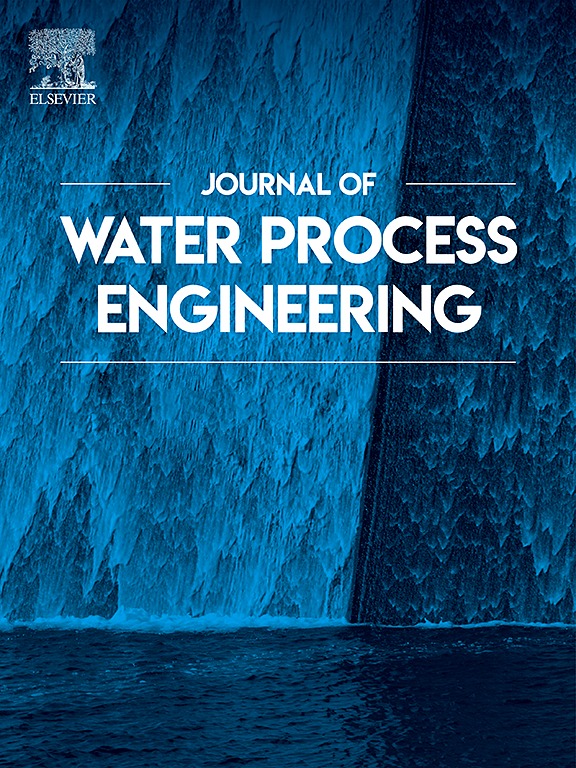用于高纯度氢氧化锂生产的多室双极膜电渗析:一个案例研究
IF 6.7
2区 工程技术
Q1 ENGINEERING, CHEMICAL
引用次数: 0
摘要
近年来,在电池产业快速增长的推动下,锂作为新能源技术领域的关键材料崭露头角。世界上很大一部分锂是在盐湖盐水中发现的,特别是在南美的锂三角、中国的青藏高原和美国西部,这使得它们的提取成为电池行业的关键焦点。本研究通过使用多室双极膜电渗析(BMED)工艺解决了从Lagkor Tso湖生产电池级氢氧化锂的关键挑战-最终产品中氯离子浓度过高。利用多腔设计的氯离子阻断效应,氢氧化锂溶液中的氯离子含量显著降低。具体来说,四室BMED系统将氯离子含量降低至传统三室系统的31 - 54%,而五室系统则将氯离子含量降低至67%。这项工作为从盐水中生产电池级氢氧化锂提供了一种创新和有效的方法,为盐湖锂提取的长期挑战提供了一种简化和有效的解决方案。本文章由计算机程序翻译,如有差异,请以英文原文为准。
Multi-chamber bipolar membrane electrodialysis for high-purity lithium hydroxide production: A case study
In recent years, lithium has emerged as a critical material in the field of new energy technologies, driven by the rapid growth of the battery industry. A significant portion of the world's lithium is found in salt lake brines, notably in South America's Lithium Triangle, China's Qinghai-Tibet Plateau, and the western United States, making their extraction a critical focus for the battery industry. This study addresses a key challenge in producing battery-grade lithium hydroxide from Lagkor Tso Lake—excessive chloride ion concentrations in the final product, by using a multi-chamber bipolar membrane electrodialysis (BMED) process. By utilizing the chlorine ion-blocking effect of the multi-chamber design, the chloride ion content in the lithium hydroxide solution was significantly reduced. Specifically, a four-compartment BMED system lowered the chloride ion content to 31–54 % of the levels observed in a traditional three-chamber system, while a five-chamber system achieved a reduction to as low as 67 %. This work provides an innovative and efficient approach for producing battery-grade lithium hydroxide from brines, offering a simplified and effective solution to a long-standing challenge in salt lake lithium extraction.
求助全文
通过发布文献求助,成功后即可免费获取论文全文。
去求助
来源期刊

Journal of water process engineering
Biochemistry, Genetics and Molecular Biology-Biotechnology
CiteScore
10.70
自引率
8.60%
发文量
846
审稿时长
24 days
期刊介绍:
The Journal of Water Process Engineering aims to publish refereed, high-quality research papers with significant novelty and impact in all areas of the engineering of water and wastewater processing . Papers on advanced and novel treatment processes and technologies are particularly welcome. The Journal considers papers in areas such as nanotechnology and biotechnology applications in water, novel oxidation and separation processes, membrane processes (except those for desalination) , catalytic processes for the removal of water contaminants, sustainable processes, water reuse and recycling, water use and wastewater minimization, integrated/hybrid technology, process modeling of water treatment and novel treatment processes. Submissions on the subject of adsorbents, including standard measurements of adsorption kinetics and equilibrium will only be considered if there is a genuine case for novelty and contribution, for example highly novel, sustainable adsorbents and their use: papers on activated carbon-type materials derived from natural matter, or surfactant-modified clays and related minerals, would not fulfil this criterion. The Journal particularly welcomes contributions involving environmentally, economically and socially sustainable technology for water treatment, including those which are energy-efficient, with minimal or no chemical consumption, and capable of water recycling and reuse that minimizes the direct disposal of wastewater to the aquatic environment. Papers that describe novel ideas for solving issues related to water quality and availability are also welcome, as are those that show the transfer of techniques from other disciplines. The Journal will consider papers dealing with processes for various water matrices including drinking water (except desalination), domestic, urban and industrial wastewaters, in addition to their residues. It is expected that the journal will be of particular relevance to chemical and process engineers working in the field. The Journal welcomes Full Text papers, Short Communications, State-of-the-Art Reviews and Letters to Editors and Case Studies
 求助内容:
求助内容: 应助结果提醒方式:
应助结果提醒方式:


